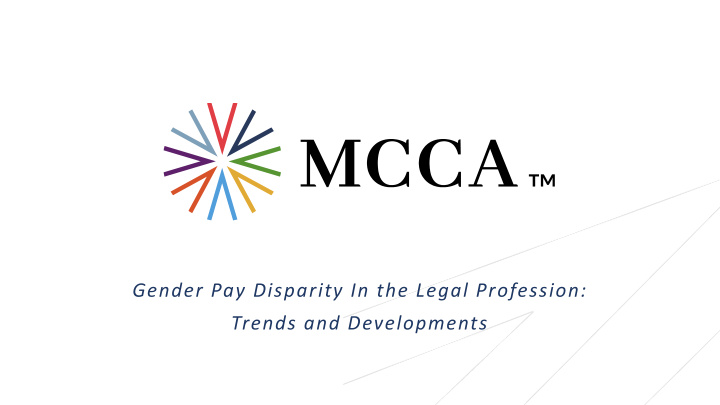



Gender Pay Disparity In the Legal Profession: Trends and Developments
Pay Equity - Overview •Median Wage Gap The Wage Gap – Defined •Pay Gap v. Adjusted Pay Gap •Overview Changes In the Pay Equity Landscape • Importance of Starting Pay Starting Salary Bans • Jurisdictional Issues • Comparison Groups Tougher State Laws • Explanatory Variables •Recent Litigation Against Law Firms Pay Equity Implications in the Legal Industry •Impact of Pay Equity Trends in the Legal Industry •Current State Law Firm Compensation •Best Practices
The “Wage Gap” Defined Gender Pay Gap: ratio of female-to-male median or average (depending on the source) yearly earnings among full-time, year-round workers. • Women earned 82% of the median usual weekly earnings of male (FT salary workers. Source BLS Report 8/2018) There are two distinct numbers regarding the pay gap: • Unadjusted pay gap. • Adjusted pay gap. Takes into account certain differences that are key to understanding pay including hours worked, occupation, education and job experience.
Current Population Survey Data – What is Missing? Legal occupations • Women earn 62.8% pay earned by men Lawyers • Women earn 83.2% of pay earned by men Judges, Judicial Clerks, Paralegals, Other Legal Support • Insufficient data to run separately • Paralegals & Miscellaneous Legal Support – no data for men
Changes in the Pay Equity Landscape The Legal Landscape Is Changing Rapidly Shareholder Advocacy Proposals Action The “Wage Gap” is being addressed in Political Agency Action Pressure numerous ways Salary History State Law Bans Changes
Importance of Starting Salary Decisions Starting salary is typically the most important pay decision • “Start Low/Stay Low” phenomenon
Long-Term Effect of Starting Pay Year Female Hire $ Female Merit Increase Male Hire $ Male Merit Increase Difference 1996 $40,000.00 4.00% $47,000.00 3.50% $ (7,000.00) 1997 $41,600.00 4.00% $48,645.00 3.50% $ (7,045.00) 1998 $43,264.00 4.00% $50,347.58 3.50% $ (7,083.58) 1999 $44,994.56 4.00% $52,109.74 3.50% $ (7,115.18) 2000 $46,794.34 4.00% $53,933.58 3.50% $ (7,139.24) 2001 $48,666.12 4.00% $55,821.26 3.50% $ (7,155.14) 2002 $50,612.76 4.00% $57,775.00 3.50% $ (7,162.24) 2003 $52,637.27 4.00% $59,797.13 3.50% $ (7,159.85) 2004 $54,742.76 4.00% $61,890.02 3.50% $ (7,147.26) 2005 $56,932.47 4.00% $64,056.18 3.50% $ (7,123.70) 2006 $59,209.77 4.00% $66,298.14 3.50% $ (7,088.37) 2007 $61,578.16 4.00% $68,618.58 3.50% $ (7,040.41) 2008 $64,041.29 4.00% $71,020.23 3.50% $ (6,978.94) 2009 $66,602.94 4.00% $73,505.93 3.50% $ (6,902.99) 2010 $69,267.06 4.00% $76,078.64 3.50% $ (6,811.58) 2011 $72,037.74 4.00% $78,741.40 3.50% $ (6,703.65) 2012 $74,919.25 4.00% $81,497.34 3.50% $ (6,578.09) 2013 $77,916.02 4.00% $84,349.75 3.50% $ (6,433.73) 2014 $81,032.66 4.00% $87,301.99 3.50% $ (6,269.33) 2015 $84,273.97 4.00% $90,357.56 3.50% $ (6,083.59) 2016 $87,644.93 4.00% $93,520.08 3.50% $ (5,875.15) Total $(143,897.05)
Recent Litigation – Legal Industry 300+ Firm 375+ Firm 700+ Firm Class action brought by junior Class action suit brought by non- Lawsuit brought by equity partner associate equity partner Settled in mid-August 2018 Sent for arbitration in June 2018 Settled in May 2017 800+ Firm 2,400+ Firm 400+ Firm Class action brought by non- Class action brought by equity Lawsuit brought by equity partner equity shareholder partner Settled in March 2018 Filed in May 2018 Filed in June 2018
Pay Equity Considerations In the Legal Industry Law Firms In-House • Often tied to prior • Individual timekeeper compensation statistics • Similar to “traditional” • Credit Allocation system compensation structures (salary bands, career level) • • Subjective Factors, such as Less variability in pay as • Good Firm citizen compared to law firms • • Reputation Especially in bonus • Quality of Work • Different drivers. • Mentoring Roles • Leadership Roles
Overview of ABA Study and Recommendations 2013 Study: Closing the Gap – Road Map for Achieving Gender Pay Equity in Law Firm Partner Compensation, Lauren Stiller Rikleen 1. Build Transparency Into the Compensation Process 2. Include a Critical Mass of Diverse Members on Compensation Committee 3. Develop Systems to Promote Fair and Accurate Allocation of Billing and Origination Credit 4. Require Diversity in Pitch Teams and Related Business Development Efforts and ensure Diverse Lawyers are part of the Client Team 5. Reward Behaviors that Promote Institutional Sustainability 6. Implement Formal Client Succession Protocols 7. Measure and Report Results 8. Develop a Process to Resolve Allocation Disputes Promptly and Fairly 9. Implement Training for All Involved in the Evaluation and Compensation Process 10. Engage the Client’s Role in Gender Equity 11. Implement System to Ensure Equitable Compensation for Partners on Reduced Hours Schedule 12. Maximize the Effectiveness of Affinity Groups
Recommend
More recommend